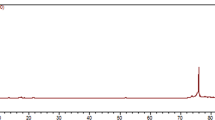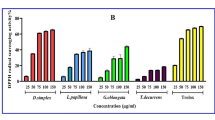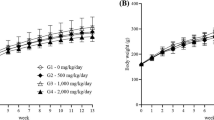Abstract
The toxicity of chloroform stem bark extract of Erythrina senegalensis DC, a medicinal plant with anti-inflammatory activity, was studied in vivo and in vitro. The LD50 i.p. of the extract was 526 mg/kg after an acute toxicity test (24 h). A brine shrimp lethality test with the extract gave LC50 of 60.86 ppm. The chronic studies revealed alterations in the levels of biochemical markers of hepatic and cardiac damage. The alterations were, however, not significant except in the group fed the highest inclusion of the extract (1.0 g extract/kg feed) where significant (p < 0.05) increases in the activities of alanine aminotransferase, aspartate aminotransferase, and alkaline phosphatase were observed. Hematological assessments of mice in this group showed significant (p < 0.05) decreases in the red blood cell count and the packed cell volume. Increases in the relative weights of the liver and heart were also significant (p < 0.05). Lipid peroxidation product levels assayed as malondialdehyde was significantly (p < 0.05) elevated in the groups fed 0.5 and 1.0 g/kg of feed at day 84. Significant histopathological changes like myocardial hemorrhages and degeneration of hepatocytes were observed in the heart and liver respectively.







Similar content being viewed by others
References
Akah PA, Nwambie AI (1994) Evaluation of Nigerian traditional medicines: plants used for rheumatic (inflammatory) disorders. J Ethnopharmacol 42:170–182. doi:10.1016/0378-8741(94)90083-3
Bessey OA, Lowry OH, Brock MJ (1964) Colorimetric method for determination of Alkaline phosphatase. Biol Chem 37:321–324
Boyd BA (1983) Clinical Enzymology. In: Kaneko JJ, Harvey JW, Bruss ML (eds) Clinical biochemistry of domestic animals, 5th edn. London, Academic, pp 285–302
Chiu D, Vinchinsky E, Klema K, Lubin B (1982) Peroxidation, vitamin E and sickle cell anaemia. In: Lubin B (ed) Vitamin E: Biochemical, Haematological and Clinical Aspects, Annals of New York Academy of Sciences 393, 323–335
Coles EH (1968) Veterinary Clinical Pathlology. W.B. Saunders, Philadelphia, pp 15–17
Dalziel JM (1948) Useful plants of West Tropical Africa, 2nd edn. Crown Overseas Agents for Colonies, London, p 362
Ijeh II, Obidoa O (2001) Effect of dietary incorporation of two varities of Vernonia amyglalna leaves on mean relative organ weights of weanling albino rats. Niger J Biochem Mol Biol 16:50–51
Iwu MM (1982) Perspectives of Igbo tribal ethnomedicine. Cecta, Enugu, pp 4–5
Iwu MM (1993) Hand Book of African Medicinal Plants. CRC, London, pp 179–180
Kaneko JJ, Harvey JW, Bruss ML (1997) Clinical biochemistry of domestic animals, 5th edn. Academic, USA, pp 285–302
McLaughlin JL, Chang CJ, Smith D (1991) Bench-top bioassays for the discovery of bioactive natural products, an update. In: Atta-ur-Rahman (ed) Studies in natural products chemistry. Elsevier Science, Amsterdam, pp 383–408
Meyer BN, Ferrigny NR, Putnam JE, Jacobsen LB, Nichols DE, Mclaughlin JL (1982) Brine shrimp: a convenient general bioassay for active plant constituents. Planta Med 45:31–34. doi:10.1055/s-2007-971236
Miller LC, Tainter MD (1937) Estimation of ED50 and LD50 values and their error using log-probit graph paper. Proc Soc Exp Biol Med 57:261–264
Nwanguma BC, Achebe AC, Ezeanyika LUS, Eze LC (1999) Toxicity of oxidized fats II: tissue levels of lipid peroxides in rats fed thermally oxidized corn oil diet. Food Chem Toxicol 37:413–416. doi:10.1016/S0278-6915(99)00023-X
Oliver B (1980) Medicinal Plants in Nigeria. Nigerian College of Arts, Sciences and Technology, Ibadan, pp 94–95
Onwurah INE (1999) Lipid peroxidation and protein oxidation in Azotobacter vinelandi exposed to mercury, silver, crude oil and Fenton reagent. J Toxicol Subs 18(4):167–176
Reitman S, Frankel S (1957) Reitman and Frankel’s colorimetric methods for estimating SGOT and SGPT. Am J Clin Pathol 28:56–63
Sandhu GS, Grewal AS, Singhi A, Kondal JK, Singhi J, Brar RS (1998) Haematological and biochemical studies on experimental Theileria annulata infection in crossbred calves. Vet Res Commun 22:347–354. doi:10.1023/A:1006129306093
Schalm OW, Jain NC, Carroll EJ (1975) Veterinary Hematology, 3rd edn. Lea and Febiger, Philadelphia, p 45
Tomita M, Okuyama T (1994) Effect of paraquat on the malodialdehyde level in rat liver microsome (in vitro). Arch Toxicol 68:187–192. doi:10.1007/s002040050053
Walling B, Rosengreen B, Shetzer HG, Camejo G (1993) Lipid peroxidation and measurement of thiobarbituric acid reacting substancces (TBARS) formation in a single microtitre plate, its use for evaluation of anti-oxidants. Ann Biochem 218:10–15. doi:10.1006/abio.1993.1002
Author information
Authors and Affiliations
Corresponding author
Rights and permissions
About this article
Cite this article
Udem, S.C., Obidoa, O. & Asuzu, I.U. Acute and chronic toxicity studies of Erythrina senegalensis DC stem bark extract in mice. Comp Clin Pathol 19, 275–282 (2010). https://doi.org/10.1007/s00580-009-0852-5
Received:
Accepted:
Published:
Issue Date:
DOI: https://doi.org/10.1007/s00580-009-0852-5




